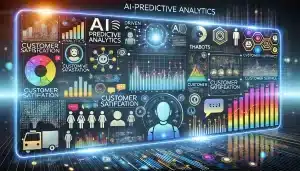In today’s rapidly evolving digital landscape, businesses look for AI-driven predictive analytics to ensure an enhanced experience in providing customer service within an evolving digital world. This emerging approach can not only facilitate the foresight of future customers’ requirements but also encourage companies to provide proactive support and improve customer satisfaction and loyalty. Companies can develop their relationships with customers, bringing every individual to the extent of delivering unique, tailor-made service catering to the desires and needs of that individual.
What is AI in Customer Service and How Does It Work?
Understanding AI-Driven Customer Service
AI in customer service refers to the use of artificial intelligence technologies in the automation and improvement of customer interactions. In other words, the incorporation of AI systems into customer service operations facilitates the processes involved in making businesses respond more quickly while providing the correct information. This also uses AI-based customer service by utilizing the power of machine learning and natural language processing algorithms for analyzing data about customers, giving an insight into how the customers will likely behave in the future. This information is what makes organizations solve their calls more efficiently. Every conversation is made flawless and productive.
The Role of Predictive Analytics in Transforming Customer Experience
Predictive analytics plays a crucial role in transforming the customer experience by enabling businesses to forecast customer needs based on historical data. By analyzing customer interactions, feedback, and behavior patterns, organizations can identify trends that inform proactive measures. This approach allows them to anticipate customer needs before issues escalate, thereby improving the overall customer service experience. For instance, a company may use predictive analytics to identify potential service disruptions and proactively reach out to customers with solutions, enhancing their satisfaction and trust in the brand.
Key Benefits of AI in Customer Service
There are quite a few benefits to adopting AI in customer support, and all these can help substantially increase the satisfaction and loyalty of the customers. The first advantage is that AI can allow you to automate those jobs which are repetitive in nature and not requiring any kind of human touch; on the other hand, the free human agents would focus more on complex problems, which actually require personal attention. Here, the real-time data analysis regarding the customers through an AI system would generate recommendations and provide solutions based on those analyses. What this means is the AI-run service will ensure on-time solutions for all questions from a customer and leads to the overall more effective and sensitive customer support organization.
How Companies Leverage AI for Predictive Customer Care
How Does A Business Implement AI in Its Company for Pre-emptive Customer Support?
What Steps Does Business Take towards Engaging Artificial Intelligence-Integrated Solutions into Operations of Predictive Service?
Customer data, the capabilities of a service team, and all technologies currently available will then be evaluated. After taking into consideration all this, the organization can begin integration using AI-based solutions. In its implementation, this process could be done by considering appropriate AI tools, equipping employees on how the solutions can be used and their eventual integration into already-existing infrastructure that supports services. This is done by taking the steps and transitioning into a more proactive approach in customer service for businesses.
Best Practices for Automating Customer Interactions
Automation of customer interaction cannot be taken lightly as technology enhances the customer experience rather than hinders it. Some of the best practices include the following: AI chatbots assist with routine inquiries while providing human agents the opportunity to dig deeper into customer issues that would require more effort to sort out. Also, frequent refreshes of the knowledge base by the firms should be carried out so the AI systems will be granted the most pertinent and precise information. Automation in customer service not only entails efficiency but also satisfies and cuts wait times, hence bringing services provided to customers as early as possible to reply to inquiries from them.
Examples of AI in Customer Service Implementation
Several companies have successfully implemented AI-driven predictive analytics to enhance their customer service interactions. For example, a leading e-commerce platform uses AI algorithms to analyze customer data and predict purchasing behavior, enabling them to provide personalized product recommendations. Similarly, a telecommunications company employs AI chatbots to address customer inquiries, providing prompt solutions to common issues while escalating more complex queries to human agents. These examples demonstrate the effectiveness of proactive customer support in improving customer engagement and satisfaction.
What Are the Benefits of AI-Driven Predictive Analytics?
Enhancing Customer Satisfaction Through AI
AI-driven predictive analytics ensures that customer needs are met proactively, thereby resulting in a significant increase in the level of customer satisfaction. Businesses can mold their offerings and communications based on what a customer wants by analyzing customer behavior and preference. This will make the customer feel more connected with the brand and increase loyalty along with satisfaction. Proactive customer support prevents problems from becoming big issues that may have been created by a lack of care about how a customer might feel.
Improving Customer Engagement with AI Systems
The use of AI can really improve customer engagement because customers would get timely and relevant information at the right time. With predictive analytics, a company will know when the customers ask certain questions, thus responding before the customers know their need. This kind of approach enhances the experience regarding customer service while urging more customer engagement with the brand. Organizations can provide such a seamless experience through the creation of an informed customer.
Proactive Customer Care: A New Standard in Customer Service
Proactive customer care is becoming the new standard in customer service fast. AI analysis of customer data, combined with predictions, can enable proactive support strategies, where issues are addressed by the company before they come up. This shift from reactive to proactive service does not only improve customer satisfaction and loyalty but also places the companies in the leadership roles in their industries. Businesses will be forced to employ an AI-powered proactive approach to the business if they wish to survive in this market and increase their profitability and growth with more and more personal and on-time service requirements from today’s competitive markets.
How Does AI Anticipate Customer Needs and Preferences?
Analyzing Customer Data for Better Insights
Advanced algorithms used by AI enable the analysis of customer data, which carries very important information about buying behavior and preferences of a customer. The AI systems can identify patterns through past interactions, purchase history, and feedback, enabling businesses to understand customers better. Through this kind of analysis, organizations can make predictions about customer needs, and the business can mold its offerings to suit customer needs. For example, if a customer often asks questions about a particular category, AI can recommend products or services that fall under that particular category, which would more likely satisfy the customer.
Personalizing Customer Experiences with AI
Personalization is one of the main elements of modern customer service. However, AI will be responsible for delivering the right, tailored experience using its access to customer data and providing personalized recommendations and content aligned with the individual’s preferences and support towards making that customer have an experience that shows loyalty and connection to a brand. Customers will want to return and spend time with the business when they feel valued and heard.
Customer Sentiment: Understanding Through AI-Driven Analytics
In fact, understanding customer sentiment is the basic way to deliver excellent customer services. AI-driven analytics enable that understanding. AI is equipped with the ability to process large amounts of customer conversation data, feedback, and social media interactions to gauge a general sense of customer feelings toward the business. Then it can identify potential concerns to be addressed. All these allow businesses to correct matters before they become unbearable to customers, thus giving a business a chance at sustaining a positive relationship. Organisations can improve their ability to provide customer service by using artificial intelligence to monitor sentiment and thereby make appropriate responses.
What does the Future Hold for AI in Customer Service?
Trends Shaping the Future of AI-Driven Service
Natural language processing, machine learning, and advanced analytics all promise a bright future in the near future for AI as it shapes customer service and offers the customer experience companies can achieve with it. Even while the AI systems continue, they are able to discern intricate customer inquiries and take proper responses. Furthermore, organizations will be able to do data-driven decisions through the assistance of AI-driven insights into their overall customer service strategy.
The Role of Human Agents in the Future: The Human Element within AI
The future of the sphere of customer service is soon going to see a plethora of change with AI continuing onward and forward with changing landscape in every sector. More so, the role that human agents play is evolving too. With routine inquiries and data-driven insights automated by AI systems, human agents would handle the more complex interactions with the customer, where empathy and emotional intelligence come into play. This would complement both systems: customers would receive the best of both worlds-in other words, efficient and automated responses for simple queries and personalized support for more intricate issues. Those businesses embracing this evolution will bring an effective and cohesive customer service experience.
Preparation towards Seamless Customer Service Experience via AI
To prepare towards seamless customer service experience through AI, businesses need to invest in the right technologies and training for their service teams. This preparation involves embracing AI-powered tools that enhance the customer interaction and providing ongoing education to human agents to make sure they are well equipped to work alongside AI systems. Organizations will be able to create a customer service experience that is both efficient and personal, resulting in improved customer satisfaction and loyalty by embracing a culture of collaboration between AI and human agents.




